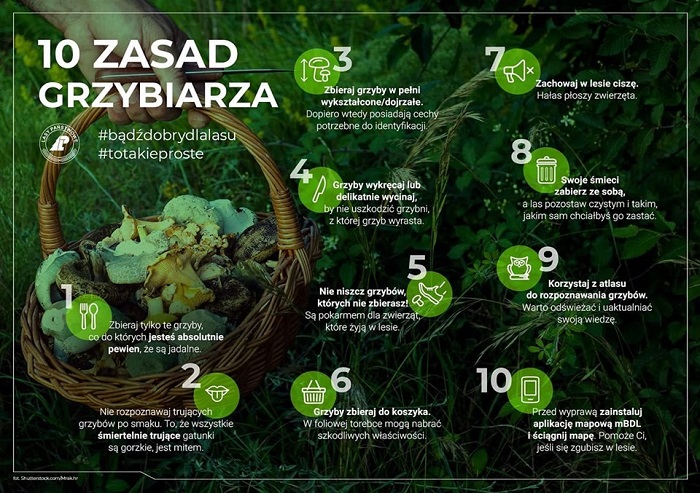Nature reserves
Landscape parks
Areas of protected landscapes
Natura 2000 areas
Natural monuments
Ecological sites
Species protection of animals
 Asset Publisher
Asset Publisher
DOBRA PASSA DLA GRZYBIARZY ROZPOCZĘTA
DOBRA PASSA DLA GRZYBIARZY ROZPOCZĘTA
Okres stosunkowo ciepłej jesieni połączonej z obfitymi opadami deszczu sprawił, że w naszych lasach nastąpił swoisty wysyp grzybów. Dla wielu osób grzybobranie to hobby, ale również okres kiedy można pozyskać smaczne okazy stanowiące składniki do wielu nietuzinkowych dań. Jest to także czas, kiedy wiele osób wybiera się do lasu.
W związku z powyższym chcielibyśmy przybliżyć kilka zasad związanych z tym zagadnieniem aby każde grzybobranie było dla nas zdrowe, satysfakcjonujące i bezpieczne.

Należy pamiętać, że grzyby są równie smaczne, co niebezpieczne, zwłaszcza wówczas, gdy ich od siebie nie odróżniamy. W Polsce występuje aż 3300 gatunków grzybów, z których tylko 44 gatunki jako jadalne zostały dopuszczone do użytku przez Ministerstwo Zdrowia. Należy też pamiętać, że 200 gatunków grzybów jest trujących, z czego kilka śmiertelnie.

Nasze wieloletnie doświadczenia wskazują, że w trakcie grzybobrania wielu amatorów tego zajęcia traci orientacje terenową w lesie. Dlatego też prezentujemy kilka podstawowych zasad umożliwiających zidentyfikowanie swojego położenia, co przyspieszy także sprowadzenie pomocy w razie potrzeby.

Na terenie Nadleśnictwa Wymiarki funkcjonuje pięć miejsc postoju pojazdów zlokalizowanych przy drogach publicznych, gdzie można zaparkować samochód wybierając się na grzyby.
Lokalizacja widoczna jest również na mapie z poziomu aplikacji Mbdl [link2] (android) lub [link3] iPhone, z menu wybierz – mapy BDL – mapa zagospodarowania turystycznego. Dodatkowo w aplikacji Mbdl można pobrać dane offline które działają w aplikacji pomimo braku internetu.
Aby móc zlokalizować się w dostępnym obszarze pomimo braku zasięgu, polecamy ściągnięcie mapy offline [załącznik poniżej] i postępowanie zgodnie z instrukcją [załącznik poniżej]







